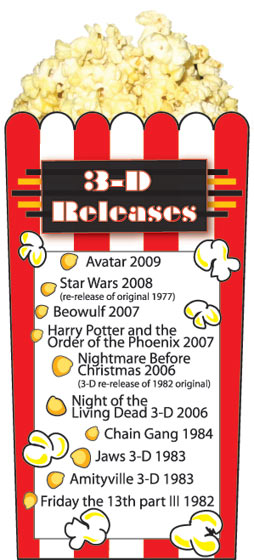By Devin Rodgers/reporter
 The days of movie theaters showing movies on standard 35mm film may soon be over. The future of movies is digital projection, which means studios will no longer have to print copies of their movies.
The days of movie theaters showing movies on standard 35mm film may soon be over. The future of movies is digital projection, which means studios will no longer have to print copies of their movies.
With the average movie using 10,000 feet of film, studios are turning toward digital projection, in which the studio delivers the film on a hard drive. Here are the advantages of making the switch:
Quality
The main advantage for moviegoers is picture quality. Imperfections like scratches, blotches and the old wear and tear the film picks up on its run through a projector will become a thing of the past. For theaters, the change is the equivalent of switching from VHS to DVD.
Cost
Digital projection circulation is only a fraction of the cost of distributing a picture on film; it is the investment of new equipment that will cut into pocketbooks of theater owners.
“The projectors themselves are actually really expensive, around a quarter of a million dollars [each],” Crystal Jordan, Northeast Mall RAVE Theater assistant manager, said.
She said by next summer the theater expects to go completely digital, with 18 digital projectors in all.
“ It’s not cheaper [for us], but it’ll definitely put us ahead of the game,” Jordan said. “People will come from other areas because we have digital.”
3-D Options
Three-dimensional pictures have always been available, especially in IMAX, which uses two film projectors and two reels of film to convey a 3-D image.
The process has always been expensive for theaters but with digital projectors becoming the norm, it makes it affordable for the first time. Now that technology is readily available, there is a real feeling that 3-D is finally coming of age.
Oscar-winning director James Cameron, known for such blockbuster films as Aliens and Titanic, expressed at a U.S. media conference that Hollywood should release more digital 3-D movies as a way of luring people back into theaters and reducing piracy, according to the Hollywood Reporter.
“ I don’t want that grand, visionary, transporting movie experience made for the big screen to become a thing of the past,” he said.
Warner Brothers has even started to release a few of its larger titles, like Batman Begins and 300 in IMAX theaters. In 2005, the studio released Superman Returns in IMAX-3-D and this summer did the same thing with Harry Potter and the Order of the Phoenix.
Tickets for 3-D features usually cost slightly more than regular movies because of the special glasses needed for such a film. There are currently about 700 theaters across the country equipped with 3-D technology.
Future 3-D’s
Several upcoming films are being produced using compatible 3-D methods, including Beowulf, directed by Robert Zemeckis (Forrest Gump). George Lucas is considering reissuing his original Star Wars movie in the format next year in celebration of the film’s 30th anniversary. Peter Jackson has similar plans for his version of
King Kong.
Avatar, with Sigourney Weaver, is one of James Cameron’s next movies. The 3-D film is estimated to cost around $200 million and is expected to hit theaters summer 2009.
In late 2005, director Steven Spielberg told the press he was involved in patenting a 3-D cinema system that is based on plasma screens and does not need glasses. A computer splits each film-frame, then projects the two split images onto the screen at differing angles to be picked up by tiny angled ridges on the screen.
Return to the big screen
According to the Motion Picture Association of America, the international box office revenues dropped 9 percent in 2005. But with new technology, the numbers could change.
“ 3-D makes periodic comebacks as technology progresses,” Douglas Davidson, NE Campus drama instructor, said. “If the image is good and the price is not prohibitive then 3-D has a chance to be a hit, particularly with the all important younger audience.”
For theater owners and studios, the technology could be a lifesaver. 3-D could help pull people away from their home theaters and DVDs to provide an experience that cannot be matched and is available only on the big screen, Davidson said.
“I think that anything that pulls audiences into theaters is worth a try,” Davidson said. “People will pay more for a while until the novelty wears off.”
Davidson said it is probably more likely that we will see more 3-D on our Plasma screens at home than in our neighborhood multiplex.
“Developing a glasses-free plasma screen 3-D process that would work for home and theatre viewing—an exciting prospect.”



























